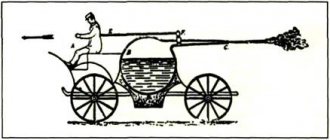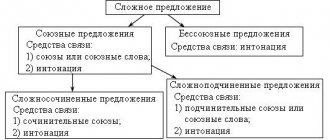Presentation on the topic: Electromagnetic induction"
Additional educational program “Preparatory course for college applicants”
Topic 1.. “The phenomenon of electromagnetic induction”
Author Korotkova A.B.
Repetition
Magnetic flux
The magnetic field at each point in space is completely characterized by the magnetic induction vector
.
Magnetic flux
Magnetic flux
Magnetic flux
through a flat surface we understand a scalar physical quantity that is numerically equal to the product of the magnetic induction module by the surface area limited by the contour and by the cosine of the angle between the normal to the surface and the magnetic induction.
Ф=BScosα
B – magnetic induction vector module
S – surface area limited by the contour
α – angle between the direction of the magnetic induction vector and the normal to the surface
[F]=[Weber]=[Wb]
1 weber
is the magnetic flux of a homogeneous
magnetic field with induction 1 Tesla
through a surface perpendicular to it
area 1 m2.
Discovery of electromagnetic induction
Michael Faraday was sure that electrical and magnetic phenomena are phenomena of the same nature.
The discovery was made on October 17, 1831.
When closing and opening, induced currents appear in opposite directions.
.
Discovery of electromagnetic induction
. Magnetism has been turned into electricity
Electromagnetic induction
An electric current also occurs if the magnet is left stationary and the coil is moved relative to it.
.
However, not every movement of a magnet (or coil) produces an electric current in the circuit.
For example
, if you rotate a magnet inside a coil, the galvanometer will not detect the presence of current in the circuit
.
Electromagnetic induction
The phenomenon of the occurrence of electric current in a closed circuit when the magnetic flux passing through the circuit changes is called the phenomenon of electromagnetic induction.
The current obtained in this way is called
induced current.
the strength of the induction current is proportional to the rate of change of the magnetic flux through the surface bounded by the contour.
Direction of induction current
Induction current counteracts the change in magnetic flux
.
If you rotate the head of the right screw according to the current in the coil, then the translational movement of the tip of the screw will indicate the direction of the magnetic field of the solenoid, and therefore its north pole.
Direction of magnetic field of induction current
the magnetic field of the induced current will prevent the change in the magnetic field generating this induced current.
The interaction between the poles always prevents the movement of the magnet.
Lenz's rule
Electromagnetic induction creates an induced current in a circuit in such a direction that the magnetic field it creates prevents the change in the magnetic flux that causes this current.
- – Find out the cause of the induction current (the magnetic flux through the circuit increases or decreases);
- – Determine the direction of the magnetic induction vector of the inducing magnetic field;
- – Find the direction of induction of the magnetic field of the induced current;
- – Based on the direction of the magnetic induction vector of the induction current, determine, using the gimlet rule, the direction of the induction current.
Homework
- EL 1.21.
- EL 1.22.
- EL 1.23.
- EL 1.24
- Assignment on the topic: “Electrical capacity”
Electromagnetic induction. Open lesson on physics in 9th grade.
- “Okay, in computer science lessons we studied this dependence in the form of a graphical model using spreadsheets, we considered modeling such a physical process as the dependence of magnetic flux (F) on the magnetic induction flux (B) and the dependence of magnetic flux (F) on the angle between magnetic induction and the normal of the circuit (cosα), and now let's transfer it to our experiments. In our experiments, the flow changed due to a change in what quantity? “Can you explain to me how this happened?”
- “The correct line of reasoning, because our field is heterogeneous. What about the third case?
- “But look, guys, in the formula we have 3 quantities on which the magnetic flux can change, but you and I have found a dependence so far on only one. We must have missed something with you. It’s not for nothing that Michael Faraday carried out his research for almost 10 years; he probably carried out other experiments. I suggest you, for 5 minutes, become great physicists in the field of electromagnetism and conduct your own experiment, which will reveal to us the secret of other dependencies. Let's split into 2 groups. Laptops in front of you, work with interactive models, remember everything you know about electric and magnetic fields and draw a general conclusion. The captain of each group will then tell us about the progress of your research. Good luck! Work in groups with Center No. 1 – slide No. 6,7.
-“You worked well in groups. Well done! But you will consider the third dependence yourself at home and describe it in detail to me in your homework. So, returning to the topic of our lesson, we can now formulate a definition and say what the phenomenon of electromagnetic induction is. With any change in the magnetic flux penetrating the circuit of a closed conductor, an electric current arises in this conductor, which exists throughout the entire process of changing the magnetic flux.
This is
the phenomenon of electromagnetic induction.
The electric current arising from the phenomenon of electromagnetic induction is called induction.
- “Let’s say again, how can we change the magnetic flux and, therefore, obtain an induced current?”
—“By changing the magnetic induction vector”
- “Due to changing the contour area”
- “By changing the orientation of the circuit relative to the magnetic induction vector”
4. Diagnostics of the quality of educational and cognitive activity
(primary consolidation of students’ knowledge on the topic of the lesson)
- “Great, guys, we did a great job with you. Well, as experienced travelers, you and I must consolidate our new knowledge so that the time spent on the road does not go in vain. An easy warm-up for you will be to complete several test tasks, they are in front of you on the screen. Carry out tasks of Center No. 5.
Presentation "Magnetic field induction". 9th grade presentation for a physics lesson (grade 9) on the topic
Slide 1
Magnetic field induction
Slide 2
The thinking mind does not feel happy until it manages to connect together the disparate facts that it observes. Hevesi
Slide 3
Theoretical questions: What is a magnetic field? What generates a magnetic field? Who first discovered the magnetic field around a current-carrying conductor?
Slide 4
How is a magnetic field represented graphically? How to obtain a picture of magnetic lines using iron filings? What are the magnetic lines of a straight conductor, a solenoid and a permanent magnet?
Slide 5
What does a magnetic field affect? How can we experimentally detect the presence of a force acting on a current-carrying conductor in a magnetic field? How to determine the direction of this force? Formulate the left-hand rule.
Slide 6
Check your homework Determine the direction of the force acting on the conductor from the side of the permanent magnet Determine the direction of the current in the conductor
Slide 8
Without a doubt, all our knowledge begins with experience. Immanuel Kant
Slide 9
Magnetic field induction Conclusion 1: Magnetic fields differ in the strength of their action on iron objects, current-carrying conductors and moving charges.
Slide 10
The magnitude of the magnetic induction vector F of the magnetic field of the current strength I of the length of the conductor LF depends on:
Slide 11
F/IL = const B = F/IL Tesla 1T = 1N/(A m) Conclusion 2: Magnetic induction is the power characteristic of a magnet. fields.
Slide 12
Direction of the magnetic induction vector Conclusion 3: Vector B is directed tangentially to the magnetic lines. The direction of vector B indicates the north pole of the magnetic needle.
Slide 13
Types of magnetic fields: Uniform field Inhomogeneous field Conclusion 4: A magnetic field is uniform if at all its points the magnetic induction is the same in magnitude and direction.
Slide 14
Answer the questions: What is the force characteristic of a magnetic field called? How is it designated? What formula is used to calculate the magnitude of the magnetic induction vector? Can we say that the modulus of magnetic induction depends on the force with which the magnet. does the field act on a conductor carrying current, the strength of the current and the length of the conductor? What is the unit of measurement of magnetic induction called? Using Figures 120,121,122 (p. 159), determine which fields are homogeneous and which are not.
Slide 15
Take the test and test yourself. Option -1 Option-2 1-A 1-B 2-B 2-A 3-A 3-B 4-A 4-B 5-B,C,D 5-A
Slide 16
Homework: § 46, answer the questions after §, exercise: 37 (written)
Slide 17
Lesson summary I understood and remembered the lesson material, I am pleased with myself. The material seemed very difficult and uninteresting to me, so I was bored.





